Early spring in Birmingham….the temperatures fluctuate up and down, and it’s still early to be planting the real heat lovers like caladiums and vinca in the ground – oh, but your fingers are itching to dig in the garden again…
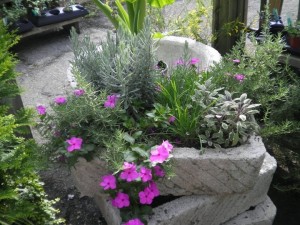
Trailing pink vinca works well with sun loving herbs of lavender, sage and chives in this trough planting….
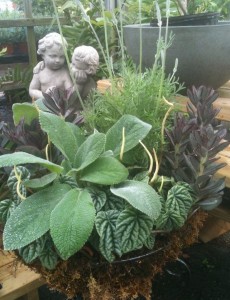
Here perennial lamb’s ear mixes with lavender, sedum and a pepperomia – (a common houseplant that also adds great texture…)
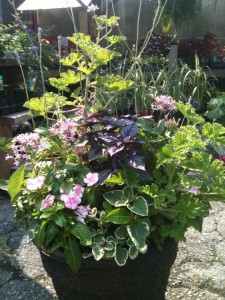
This combination for sun includes pentas, scented geraniums, vinca, purple basil, and variegated Swedish ivy meandering through the entire composition…
Happily, you can begin planning your summer container plantings, which can also be great springboards for future garden groupings – testing them in a pot first is a safe and fun way to experiment.
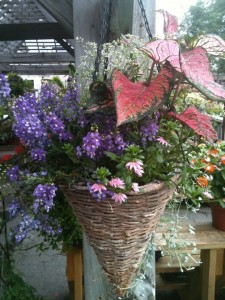
This hanging basket for sun includes a sun loving caladium, angelonia, pink fan flower, trailing silver dichondra, and an airy white euphorbia…
These pictures are container combos from seasons past – all lasted through the brutal heat of summer given water, deadheading and cutting back as necessary.
The old cliché of using a “thriller, filler and spiller” has been much used, (Maybe a little too much?) but don’t feel tied to it please! Designing creative plantings shouldn’t be absolute or bound by rigid rules.
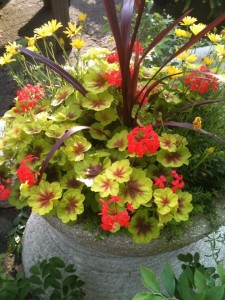
‘Indian Dune’s’ fancy leaf geranium, cordyline and thyme work in half day or full sun…
However, do try to combine plants that appreciate the same amount of light and water and have growing habits that compliment one another.
If you can do that, any plant combo you like within those parameters is fair game. There are many plants that will handle a lot of sun but still appreciate a little shade, especially in the afternoon, when the heat is the most brutal. Others will need partial to full shade in our climate. The important thing is to choose the right plants for whatever conditions you have.
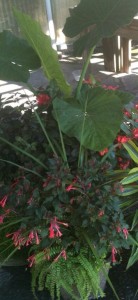
Elephant ears add drama, with a heat tolerant fuschia, ‘Gartenmeister’ and a trailing maidenhair fern – this one was planted with a shady area in mind…
The larger the container your space can accommodate the better! Not only will you be able to add more plants, but watering will be easier as well. Having said that, when maintaining large planters, if temperatures are in the 90’s every day and lows don’t get below the 70’s at night (July and August in Birmingham!), be prepared to water every day, even if your planters are in only half day sun. Of course, there are always exceptions…succulents, purslane, portulaca – these are a few plants that can take dry soil and heat, but even they will need water eventually!
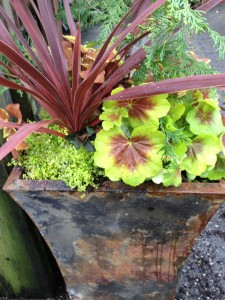
Cordyline, fancy leaf geranium, baby tears…morning sun and afternoon shade or filtered sun suit this planting…
Plant choices change weekly during the height of spring and it can be overwhelming…we’re happy to help you come up with the right combinations of plants for your containers if you’re unsure. Just be sure you know how much sun (or not!) they receive and the sizes of your planters, and we can take it from there.
Another tip: Flowers aren’t always what adds the most pizazz. There are great foliage choices out there, many that add color with no blooms at all. Some of the most striking planters are those done with just foliage – try it sometime!
If you follow us on Instagram or Facebook you’ve probably seen a new series of shop videos – if not, follow us and check them out! They’re also on our YouTube channel under Oak Street Garden Shop – if you’d like to see more, subscribe!
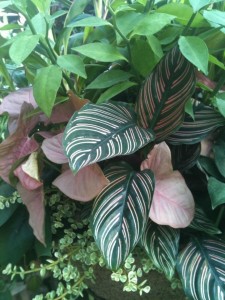
Foliage is as interesting as flowers!
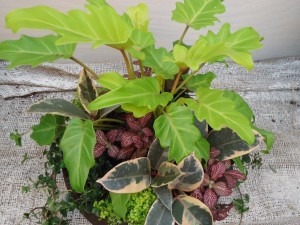
A shade planter – all foliage!
By Kris Blevons


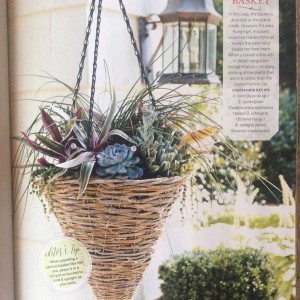
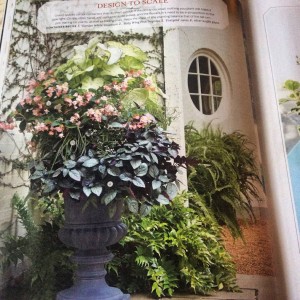
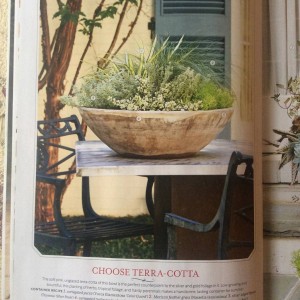
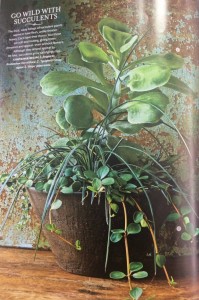
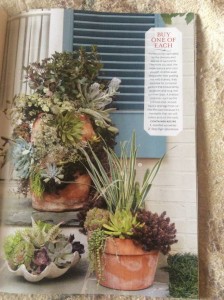
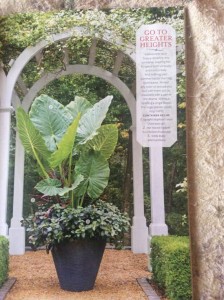
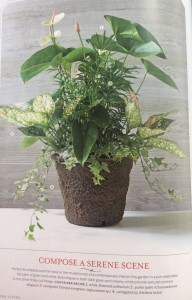
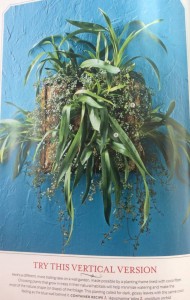
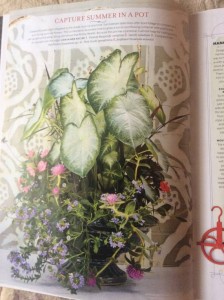
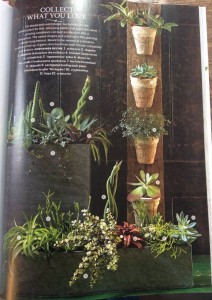
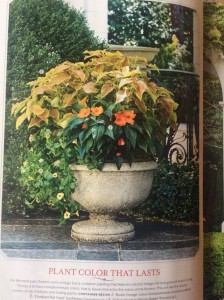


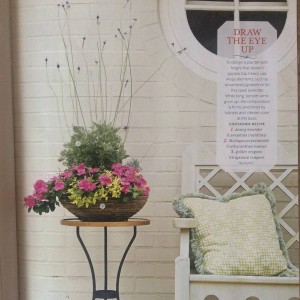
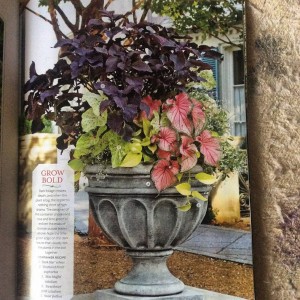
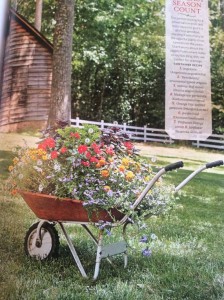

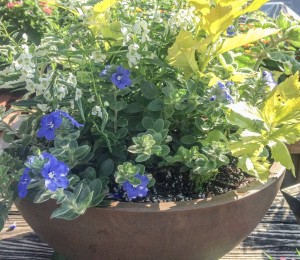
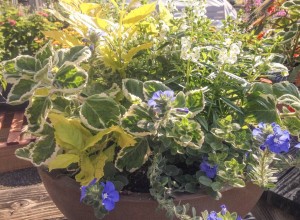
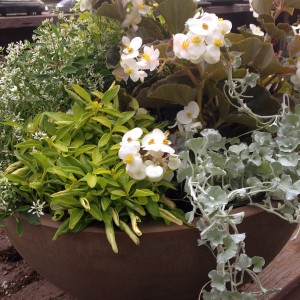

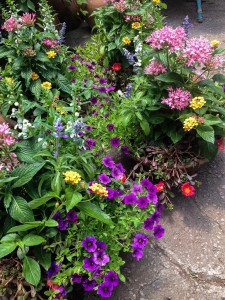
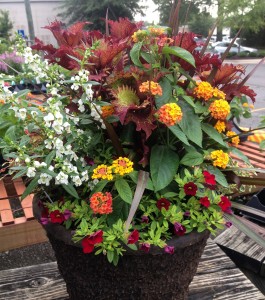 Many of the container plantings we do are in light, mâché pots that can either be used on their own or placed in another planter. Here’s one with a mix of sun coleus, a dracaena (Barely visible in this picture, it adds a spiky leaf.), lantana, red million bells to trail, and a white angelonia. This planting will get much larger and fuller as the heat of summer settles in, and daily watering will be necessary.
Many of the container plantings we do are in light, mâché pots that can either be used on their own or placed in another planter. Here’s one with a mix of sun coleus, a dracaena (Barely visible in this picture, it adds a spiky leaf.), lantana, red million bells to trail, and a white angelonia. This planting will get much larger and fuller as the heat of summer settles in, and daily watering will be necessary.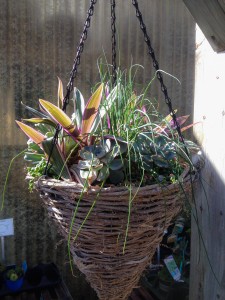 The white, cone-shaped hanging basket shown here is now home to a common houseplant, an herb, and some succulents. While it may seem an unusual combination, it’s working quite nicely and has a cool, summery look. The houseplant is a pink and green tradescantia (It’s also known as Rhoeo spathacea.), sometimes called Moses In The Cradle.
The white, cone-shaped hanging basket shown here is now home to a common houseplant, an herb, and some succulents. While it may seem an unusual combination, it’s working quite nicely and has a cool, summery look. The houseplant is a pink and green tradescantia (It’s also known as Rhoeo spathacea.), sometimes called Moses In The Cradle.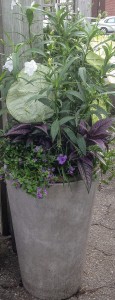 We have a few tall, lightweight planters still available, and this planting shows one of them off. A tall, white ruellia (They’re sometimes called perennial petunia.) is combined here with a caladium whose leaves will get very large. The name of this one is ‘Garden White’, and it’s impressive! The large leaves will contrast nicely with the smaller leaves of the ruellia. Another foliage contrast is provided by the silvery-purple leaves of a strobilanthes, sometimes called Persian Shield. A beautiful foliage plant, it benefits from a cutback every now and then if it gets to lanky in the planting. To trail there’s a blue fanflower, scaevola.
We have a few tall, lightweight planters still available, and this planting shows one of them off. A tall, white ruellia (They’re sometimes called perennial petunia.) is combined here with a caladium whose leaves will get very large. The name of this one is ‘Garden White’, and it’s impressive! The large leaves will contrast nicely with the smaller leaves of the ruellia. Another foliage contrast is provided by the silvery-purple leaves of a strobilanthes, sometimes called Persian Shield. A beautiful foliage plant, it benefits from a cutback every now and then if it gets to lanky in the planting. To trail there’s a blue fanflower, scaevola. Finally, since we had a few ‘Carolina Sapphire’ cypress left, they were candidates for a planting using smaller plants at the base to add fullness, color, and trail. These planters will be in the sun and can be changed out in the fall with the addition of pansies and other cold weather plants for the winter season.
Finally, since we had a few ‘Carolina Sapphire’ cypress left, they were candidates for a planting using smaller plants at the base to add fullness, color, and trail. These planters will be in the sun and can be changed out in the fall with the addition of pansies and other cold weather plants for the winter season.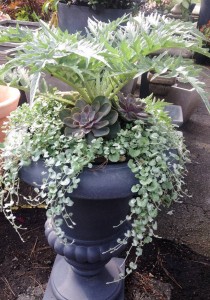
 The next uses a red fountain grass for height in a tall planter with the addition of white Profusion zinnias and white euphorbia as fillers. Spilling out are blue daze and potato vine. This planting will bloom continuously with regular water and periodic deadheading or clipping back of the zinnias. Late in the summer the grass will begin to bloom for an end of the season finale.
The next uses a red fountain grass for height in a tall planter with the addition of white Profusion zinnias and white euphorbia as fillers. Spilling out are blue daze and potato vine. This planting will bloom continuously with regular water and periodic deadheading or clipping back of the zinnias. Late in the summer the grass will begin to bloom for an end of the season finale.
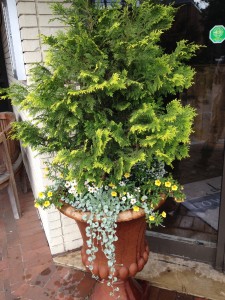 Many of you have pots that have shrubs in them that live year round, and just need some color added each season. In this example, the Chamaecyparis adds yellow foliage and is complimented through the summer with yellow million bells, white narrow leaf zinnias, silver dichondra and some euphorbia. The million bells and zinnias will be cut back when they get too leggy (There’s no need to deadhead each individual bloom on these.) and it will be watered daily, since the Chamaecyparis has been in this planter for a few years and it’s roots are filling the planter quite extensively.
Many of you have pots that have shrubs in them that live year round, and just need some color added each season. In this example, the Chamaecyparis adds yellow foliage and is complimented through the summer with yellow million bells, white narrow leaf zinnias, silver dichondra and some euphorbia. The million bells and zinnias will be cut back when they get too leggy (There’s no need to deadhead each individual bloom on these.) and it will be watered daily, since the Chamaecyparis has been in this planter for a few years and it’s roots are filling the planter quite extensively.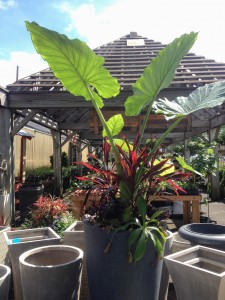 The final planting uses a dramatic, and very large Alocasia – this speaks for itself, though it has supporting players as well, including dracaena, epescia, nepenthes, and alternanthera. It’s quite a combo.
The final planting uses a dramatic, and very large Alocasia – this speaks for itself, though it has supporting players as well, including dracaena, epescia, nepenthes, and alternanthera. It’s quite a combo.
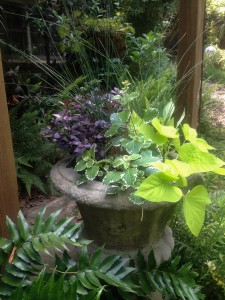
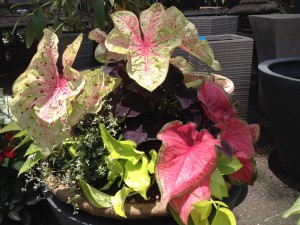
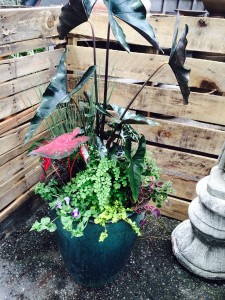 Sometimes it’s fun to try a plant that’s more unusual as the centerpiece of a design. In this glazed pot the dark leaf of the Alocasia is a beautiful contrast to the coleus, grasslike juncus, maidenhair fern, trailing torenia, and creeping jenny.
Sometimes it’s fun to try a plant that’s more unusual as the centerpiece of a design. In this glazed pot the dark leaf of the Alocasia is a beautiful contrast to the coleus, grasslike juncus, maidenhair fern, trailing torenia, and creeping jenny.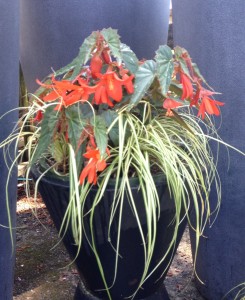 Finally, here’s a simple planting for shade using a begonia and the contrasting leaf and brightness of carex ‘Evergold’, which will spill over the edge of the container. Simple, yet effective. The begonia will continue to bloom with a couple of cutbacks if it gets “leggy.”
Finally, here’s a simple planting for shade using a begonia and the contrasting leaf and brightness of carex ‘Evergold’, which will spill over the edge of the container. Simple, yet effective. The begonia will continue to bloom with a couple of cutbacks if it gets “leggy.”